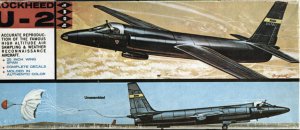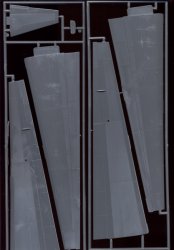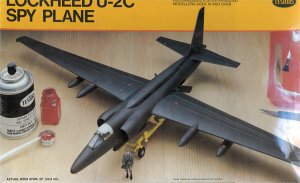From Internet Modeler
Testors/Hawk 1/48 U-2 Spyplane - Another Look
By Michael Benolkin
Feb 1, 2002 - 5:35:45 PM
Background
The Lockheed Skunkworks, under the famous Kelly Johnson, was given the task to create a new generation of high-altitude reconnaissance aircraft that could fly virtually anywhere in the world, safely above any air defenses of the day. What emerged from their drawing board was a lightweight, turbine-powered sailplane that could loft a pilot and reconnaissance payload up to the edge of space, well above the altitude where the blood in an unprotected human body will begin to boil.
The U-2 was one of the most successful airborne reconnaissance platforms ever developed. The U-2A evolved into specialized variants, and when additional payload capacity was required, the J57 that powered the U-2A gave way to the J75 that powered the U-2C and its derivatives. The secret of the U-2 lies in its simplicity. Any 'features' you'd expect in an operational jet aircraft would only add weight to the U-2 and affect it's performance. For example, early U-2s were not equipped with an ejection seat to save weight.
Despite the success of the U-2, the Skunkworks was hard at work on the next generation of reconnaissance platform, the A-11/A-12 series (which evolved into the SR-71) that could operate even above the Soviet Union's improved air defenses. While the SR-71 was envisioned to replace the U-2, ironically enough the U-2 would re-enter production with a much larger payload capacity and enter service as the U-2R. Even though the SR-71 has been retired (several times), the U-2R/TR-1 series remains operational today.
The Kit
 Hawk first released this kit 40 or so years ago as the U-2A. Somewhere along the way, the molds were updated into the U-2C configuration with enlarged intakes. Eventually the molds would also receive the dorsal hump. Testors acquired all of the kit molds when they purchased Hawk and issued these kits under the Testors label. The U-2C would become one of the longest running kits in injection molded history.
Hawk first released this kit 40 or so years ago as the U-2A. Somewhere along the way, the molds were updated into the U-2C configuration with enlarged intakes. Eventually the molds would also receive the dorsal hump. Testors acquired all of the kit molds when they purchased Hawk and issued these kits under the Testors label. The U-2C would become one of the longest running kits in injection molded history.



As you can see in these pictures, the basic Hawk U-2A kit comes on four parts trees (plus an additional tree with the clear parts). Straight out of the box, there are few parts in this kit, yet it builds into a beautiful representation of the U-2. Of course, 40 years ago it wasn't uncommon to have flash on sprues that came from new molds as injection-molding technology was still relatively new. And of course, detail in 40-year-old model kits was virtually non-existent. The fact that this kit offered a fairly nice cockpit for its day and even a standing pilot figure was a testament to its designers.
 Despite its age, the Testor's kit is just as crisp and clean as the original Hawk issue. The picture to the right shows the U-2C fuselage from the kit that is still available at most hobby shops. While the rest of the kit is identical to the shown parts above, the fuselage shows the added dorsal spine, the shorter and wider exhaust duct, and the fairings for the enlarged intakes.
Despite its age, the Testor's kit is just as crisp and clean as the original Hawk issue. The picture to the right shows the U-2C fuselage from the kit that is still available at most hobby shops. While the rest of the kit is identical to the shown parts above, the fuselage shows the added dorsal spine, the shorter and wider exhaust duct, and the fairings for the enlarged intakes.
In the 40 years of this kit's existence, I can only recall two decal sheets from Microscale that offered any variety or options for this kit - until now.
We looked at a decal sheet and a cockpit detail set for the Hawk/Testors kit from Cutting Edge Modelworks last October. Since that time, Cutting Edge has released two additional decal sheets and seven (7!) additional detail sets. These are all reviewed elsewhere in this issue of Internet Modeler.
Conclusion
With all of this cool aftermarket accessories now available for the early U-2 kits, I thought it might be worth another look at the basic kits. Despite its age, the Hawk and Testors kits are the only options for a 1/48 early-model Lockheed U-2. With the release of all of these aftermarket decals and details from Cutting Edge, it is now possible to build a U-2 that would be able to compete with contemporary models without a great deal of research and scratchbuilding.
Dust off that U-2 kit!
© Copyright 2023 by Internet Modeler


 Hawk first released this kit 40 or so years ago as the U-2A. Somewhere along the way, the molds were updated into the U-2C configuration with enlarged intakes. Eventually the molds would also receive the dorsal hump. Testors acquired all of the kit molds when they purchased Hawk and issued these kits under the Testors label. The U-2C would become one of the longest running kits in injection molded history.
Hawk first released this kit 40 or so years ago as the U-2A. Somewhere along the way, the molds were updated into the U-2C configuration with enlarged intakes. Eventually the molds would also receive the dorsal hump. Testors acquired all of the kit molds when they purchased Hawk and issued these kits under the Testors label. The U-2C would become one of the longest running kits in injection molded history.


 Despite its age, the Testor's kit is just as crisp and clean as the original Hawk issue. The picture to the right shows the U-2C fuselage from the kit that is still available at most hobby shops. While the rest of the kit is identical to the shown parts above, the fuselage shows the added dorsal spine, the shorter and wider exhaust duct, and the fairings for the enlarged intakes.
Despite its age, the Testor's kit is just as crisp and clean as the original Hawk issue. The picture to the right shows the U-2C fuselage from the kit that is still available at most hobby shops. While the rest of the kit is identical to the shown parts above, the fuselage shows the added dorsal spine, the shorter and wider exhaust duct, and the fairings for the enlarged intakes.